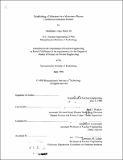Establishing a calibration for a microwave plasma continuous emissions monitor
Author(s)
Flores, Guadalupe J. (Guadalupe Jorge)
DownloadFull printable version (4.449Mb)
Advisor
Paul P. Woskov and Kenneth R. Czerwinski.
Terms of use
Metadata
Show full item recordAbstract
In an effort to provide an accurate real-time continuous emissions monitor (CEM) for hazardous air-pollution metals as a viable option to EPA Method 29, a Microwave Induced Plasma (MIP) system is under development for real-time atomic emission spectroscopy in stack exhaust. This MIP-CEM has a nebulizer calibration subsystem attached to the sample line for real-time span calibration of the monitored metal concentrations. In order to quantify the amount of metal mass measured in the effluent flow, it is necessary to determine the analyte metal mass transport efficiency of the nebulizer system. A novel new approach to determine the nebulizer efficiency during plasma operation was tested in this thesis. A 0.1-mm tungsten filament attached to a 4- mm diameter alumina rod was used to introduce a known amount of mass into a nitrogen plasma at 0.5-cfm sample line flow in 6 different positions relative to the end of the sample line. The tungsten filament was heated by plasma radiation. These signals, obtained from the direct rod insertions, were then correlated to masses of metals aspirated by the nebulizer and drawn into the plasma through a quartz "T". The mass transport efficiency as a function of rod insertion position was calculated by dividing the correlated mass by the total mass aspirated by the nebulizer to achieve an identical signal. In the 4- inch long drift distance between the end of the sample line and the plasma sustaining waveguide, measurements from 0.5 inches away from the end of the sample line to 1.75 inches away, in 0.25-inch increments, were repeated, and the results tabulated. The efficiencies generally decreased as the rod was inserted closer to the plasma, with the efficiency extrapolated to 0.644 ± 0.153 % at the end of the sample line. The extrapolated value is in fair agreement with the efficiency used in the most recent field test conducted at Research Triangle Park in Raleigh-Durham, North Carolina. Initial tests at one insertion location of 1.75 in. were also done for a different nitrogen flow of 1.0 cfm and for air at 0.5 cfm. These initial tests are inconclusive, and more measurements are needed. Also, further testing is warranted for the determination of other factors, such as moisture, and the impact on the efficiency.
Description
Thesis (S.M.)--Massachusetts Institute of Technology, Dept. of Nuclear Engineering, 1998. Includes bibliographical references (leaves 53-54).
Date issued
1998Department
Massachusetts Institute of Technology. Department of Nuclear Science and EngineeringPublisher
Massachusetts Institute of Technology
Keywords
Nuclear Engineering